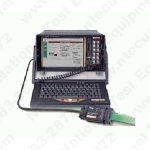Description
The broadband communications age has been created by several factors: advancement in signal processing technology, new radio frequency spectrum allocations, as well as today’s insatiable desire for information services. RF communication technology in the CATV, satellite, DTV, MDS, and wireless market spaces have driven the need for accurate, comprehensive generation of RF channel impairments, such as noise and interference.
Noise and RF Interference Generation
To meet the requirements of contemporary digital demodulator testing, a noise and interference test set must meet the following criteria:
1. Carrier to Noise PLUS Interference
Realistic generation of real-world ambient conditions in the lab requires simultaneous level setting and summing of in-band and out-of-band impairments with accurately ratioed carrier and noise. The FB2000A provides this capability with up to four external analog or digital RF impairments. These external interferer signals can be added anywhere in the 5 MHz to 2.4 GHz spectrum, and ratioed to the carrier with 0.1dB resolution and 0.1 dB accuracy, thus supporting co-channel, adjacent channel and total interferer power test requirements. Industry standard conformance tests for BER can be run from this instrument without the use of external RF attenuators, combiners or additional test fixtures.
2. Frequency Tunable Noise
Inherent in the FB2000A architecture is its frequency tunable noise source.The instrument’s frequency synthesizer facilitates noise addition in five user-selectable bandwidths at ANY frequency from 5 MHz to 2.4 GHz. This capability supports current and future demodulator IF and RF input frequencies, without the need for external frequency translation.
Demodulator BER test procedures often specify carrier input amplitude, as well as carrier-to-noise ratio settings. By adding noise directly at RF, the carrier level, as well as C/N ratio can be set internally to the FB2000A, eliminating the need for additional external attenuation. For automated measurements, this simplifies testing considerably.
Finally, broadband noise sources are avoided by using a frequency agile approach to achieve wide band frequency coverage. Because narrower and flatter noise filters can be used in the test set, enhanced carrier-to-noise ratio accuracy is achieved.
3. Mixed Impedance Operation
Wide band 75 and 50 Ohm dual inputs ease the test set’s use in mixed impedance environments.
4. High Accuracy, Wide Range EbNo, over Large Carrier Dynamic Range
Even at high carrier output power the FB2000A is equipped with ample noise power to set low carrier-to-noise ratios. By matching noise bandwidths to the bandwidth of the test object, high in-band noise densities are achievable without overloading the test device’s front end.
In contrast, the instrument’s proprietary technology also allows setting of high carrier-to-noise ratios at carrier power levels as low as –140 dBm, while maintaining the instrument’s intrinsic accuracy. This is particularly useful for low data rate applications, e.g. VSAT, cellular, etc.
5. Upstream and Downstream Continuous or Burst Noise
Upstream cable and digital TV transmissions require error-free demodulator performance in the presence of burst noise. The FB2000A allows both internal and external setting of burst noise duration and arrival times. The user can also control gating of the noise source by supplying an external TTL signal.For full duplex transmission when noise addition is desired in both the upstream and downstream paths, a two channel configuration of the FB2000A is available.A full duplex cable impairment with both burst and continuous noise can be simulated by including the CATV diplexer option with this configuration.
6. Carrier and Interferer Flat Fading
A receiver's AGC is designed to mitigate rapid carrier power fluctuations caused by rainfall or other path obstructions. To simulate this effect, the FB2000A allows the user to program a desired C/N ratio, and then adjust the carrier path attenuation with sinusoidal, triangle, or square wave profiles while keeping the noise level fixed.
Alternatively, interferer or noise signal levels can be varied using the same approach, while keeping the carrier level fixed. This can be useful for simulating the effects of interference introduced by unknown sources.
Specifications & Attributes (Noise [Source/Figure Meter])
| Form Factor |
|---|
| Benchtop |
| Frequency |
|---|
| 5 MHz - 2.4 GHz |
